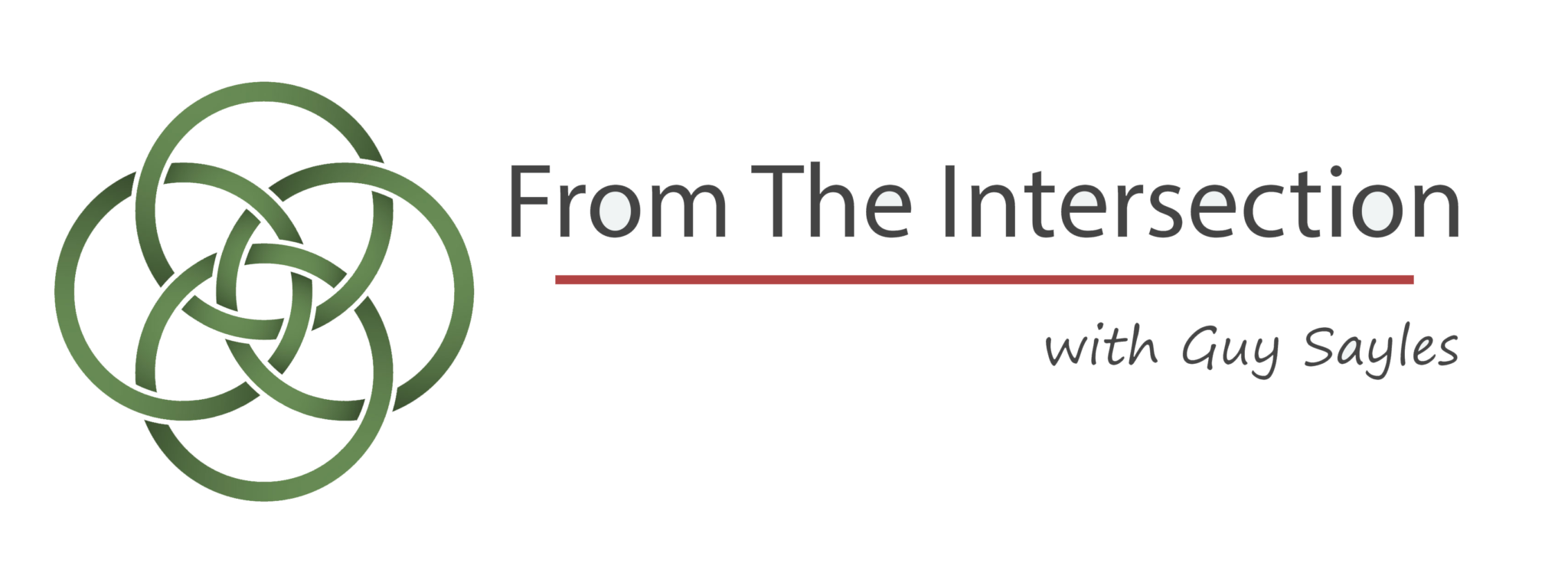
Mark Ward, Guy Sayles, Ronald K. Brown, Jasmine Beach-Ferrara
This afternoon, I had the joy to be part of a conversation occasioned by the visit of choreographer Ronald K. Brown who is the artistic director of Evidence Dance Company (scheduled to perform in Asheville on November 10-11 at the Diana Wortham Theater). Diana Wortham’s Managing Director Rae Geoffrey moderated a discussion between Brown, Jasmine-Beach-Ferrara (County Commissioner and Executive Director of the Campaign for Southern Equality), Mark Ward (Lead Minister of the Unitarian-Universalist Congregation of Asheville) and me about “art and spirituality.” Here’s part of what I had to say:
In 1965, Duke Ellington gave a concert at San Francisco’s then-new Grace Episcopal Cathedral. Ellington relished the opportunity; he said: “Now I can say loudly and openly what I have been saying to myself on my knees.” And what had he been saying? And what did he now say openly? Here are titles of some of Ellington’s pieces:
“Father Forgive”
“Is God a Three-Letter Word for Love?”
“Every Man Prays in His Own Language”
“Praise the One who created and sustained and redeemed all of this.”
“Ain’t Nobody Nowhere Nothin’ Without God”
and “Praise God and Dance.”
Dance is as fine a metaphor for the connection of the arts and spirituality as I know. That’s true, in part, because of the sheer physicality of dance. All art is inherently physical-material: it involves breath, bones, and muscle; diaphragm, lungs, vocal cords; arms, hands, and fingers; legs, feet, and toes; bones, muscles, and blood; instruments of metal and wood; violin strings made of sheep’s guts; clay and fire; pigments, canvass and brushes made of goats hair; words scribbled with a pencil made of wood and lead or appearing, digitized, on a previously blank screen.
The majestic prologue to the Gospel of John, which is a hymn about Jesus offers us a powerful metaphor for spirituality and art: “And the Word became flesh and lived among us, and we have seen his glory, a glory filled with grace and truth.”
Theologians call this metaphor “the incarnation,” which comes from the Latin phrase in carne and means “in meat.” So, incarnation makes a startling claim: in the meat of Jesus’ body, we may perceive the grace and truth of God.
I don’t think of the incarnation as something which happened once and exclusively in Jesus; instead, I am sure that incarnation keeps happening to everyone, everywhere, and “every-when.” Feminist theologian Wendy Farley wrote, in The Wounding and Healing of Desire, “The incarnation manifests the power of the human body to bear the divine.”
Incarnation is what makes in possible find joy in a dancer’s flowing beauty or explosive grandeur, enlightenment in a painter’s luminous canvas, ourselves as were or could be or both in a Rodin sculpture, our comedy or tragedy or both in a play’s unfolding scenes, and clues to our identity in a writer’s portrayal of someone who seems, on the surface, so different from us. In these ways, and countless others, the mysteries and marvels, glories and grotesqueries that others have seen, heard, and felt, become flesh or matter so that we, too, can see, hear, and feel.
Leonard Bernstein once said that, for him, “music is cosmos in chaos.” Agreeing with him, Madeline L’Engle said that “. . . all art is cosmos, cosmos found within chaos” (Walking on Water).
Art, like creation itself, comes out of chaos. And, in the chaos of our time, we need the cosmos and coherence of art: people who can sing peace from the battlefield; sculpt hope from the clay we make from the dry dust of despair and scalding tears; weave beauty from threads of death and ugliness; paint love on empty canvasses; and speak words which call light and warmth into the darkness and chill of our harsh times.
Discover more from From The Intersection
Subscribe to get the latest posts sent to your email.


Guy, once again you have blessed us with the dance metaphor. As ever you evoke in me the final lines from “Among School Children” [W.B.Yeats]:
O body swayed to music, O brightening glance,
How can we know the dancer from the dance?
I love the idea that ‘cosmos (order?) arises within chaos’ rather than that ‘order is imposed upon chaos.’ I am fond of thinking that the G-d of Genesis 1 calls “May (Let) there be light” and in ‘response’ to the ‘invitation’ light happens/becomes/comes forth (“there was light”).
Still Wallace Stevens is a cautionary reminder [“The Idea of Order at Key West”]:
She sang beyond the genius of the sea . . . we knew / It was the spirit that we sought and knew / That we should ask this often as she sang. . . . Then we . . . / Knew that there never was a world for her / Except the one she sang and, singing, made. . . . Oh! Blessed rage for order, pale Ramon, / The maker’s rage to order words of the sea . . .
Many of us have heard the G-d who is Love calling us to participate in cosmos-making. I hope in our response we continue to sense there is no “dancer [apart] from the dance.”
Shalom, Dick
Thank you, Dick, for your response and especially for the reminder of W Stevens’ powerful lines. I don’t believe that God "imposes" much of anything; the divine’s investment in freedom seems to be nearly total. Best, Guy